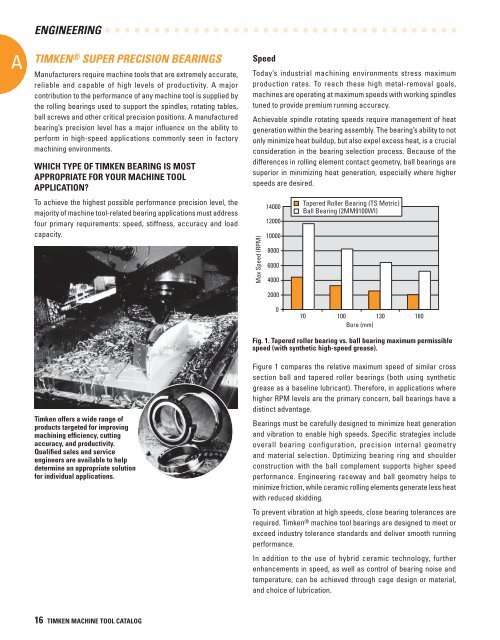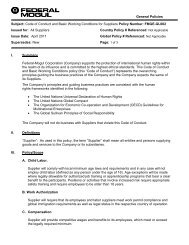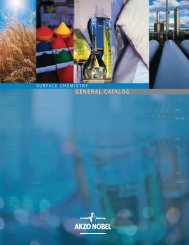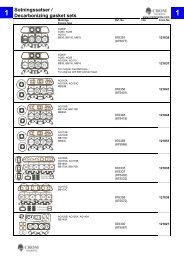Create successful ePaper yourself
Turn your PDF publications into a flip-book with our unique Google optimized e-Paper software.
A<br />
ENGINEERING<br />
TIMKEN ® SUPER PRECISION BEARINGS<br />
Manufacturers require machine tools that are extremely accurate,<br />
reliable and capable of high levels of productivity. A major<br />
contribution to the per<strong>for</strong>mance of any machine tool is supplied by<br />
the rolling bearings used to support the spindles, rotating tables,<br />
ball screws and other critical precision positions. A manufactured<br />
bearing’s precision level has a major influence on the ability to<br />
per<strong>for</strong>m in high-speed applications commonly seen in factory<br />
machining environments.<br />
WHICH TYPE OF TIMKEN BEARING IS MOST<br />
APPROPRIATE FOR YOUR MACHINE TOOL<br />
APPLICATION?<br />
To achieve the highest possible per<strong>for</strong>mance precision level, the<br />
majority of machine tool-related bearing applications must address<br />
four primary requirements: speed, stiffness, accuracy and load<br />
capacity.<br />
Speed<br />
Today’s industrial machining environments stress maximum<br />
production rates. To reach these high metal-removal goals,<br />
machines are operating at maximum speeds with working spindles<br />
tuned to provide premium running accuracy.<br />
Achievable spindle rotating speeds require management of heat<br />
generation within the bearing assembly. The bearing’s ability to not<br />
only minimize heat buildup, but also expel excess heat, is a crucial<br />
consideration in the bearing selection process. Because of the<br />
differences in rolling element contact geometry, ball bearings are<br />
superior in minimizing heat generation, especially where higher<br />
speeds are desired.<br />
Max Speed (RPM)<br />
14000<br />
12000<br />
10000<br />
8000<br />
6000<br />
4000<br />
2000<br />
Tapered Roller Bearing (TS Metric)<br />
Ball Bearing (2MM9100WI)<br />
0<br />
70 100 130 160<br />
Bore (mm)<br />
Fig. 1. Tapered roller bearing vs. ball bearing maximum permissible<br />
speed (with synthetic high-speed grease).<br />
<strong>Timken</strong> offers a wide range of<br />
products targeted <strong>for</strong> improving<br />
machining efficiency, cutting<br />
accuracy, and productivity.<br />
Qualified sales and service<br />
engineers are available to help<br />
determine an appropriate solution<br />
<strong>for</strong> individual applications.<br />
Figure 1 compares the relative maximum speed of similar cross<br />
section ball and tapered roller bearings (both using synthetic<br />
grease as a baseline lubricant). There<strong>for</strong>e, in applications where<br />
higher RPM levels are the primary concern, ball bearings have a<br />
distinct advantage.<br />
<strong>Bearings</strong> must be carefully designed to minimize heat generation<br />
and vibration to enable high speeds. Specific strategies include<br />
overall bearing configuration, precision internal geometry<br />
and material selection. Optimizing bearing ring and shoulder<br />
construction with the ball complement supports higher speed<br />
per<strong>for</strong>mance. Engineering raceway and ball geometry helps to<br />
minimize friction, while ceramic rolling elements generate less heat<br />
with reduced skidding.<br />
To prevent vibration at high speeds, close bearing tolerances are<br />
required. <strong>Timken</strong> ® machine tool bearings are designed to meet or<br />
exceed industry tolerance standards and deliver smooth running<br />
per<strong>for</strong>mance.<br />
In addition to the use of hybrid ceramic technology, further<br />
enhancements in speed, as well as control of bearing noise and<br />
temperature, can be achieved through cage design or material,<br />
and choice of lubrication.<br />
16 TIMKEN MACHINE TOOL CATALOG







